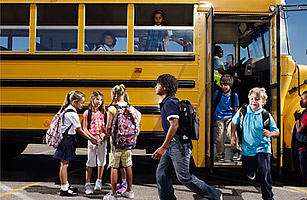
Kids like these in Los Angeles are starting the school year with high hopes — and so are reformers
(2 of 4)
The third novelty is in Washington, where a Democratic President is standing up to his party's most dysfunctional long-term romantic interest, the teachers' unions. President Barack Obama and his Education Secretary, Arne Duncan, have dangled $4.35 billion in stimulus money in front of cash-strapped state legislatures to get them to rationalize their systems. Overnight, the White House has become the biggest benefactor in the education world, far surpassing the Bill & Melinda Gates Foundation. The competition, known as Race to the Top, is pushing school districts to raise academic standards, to evaluate teachers based in part on how much their students are learning, to train teachers more effectively — and to remove those who are not cut out for the job.
In the states' response, we are witnessing what may be the beginning of a commonsense revolution. Seven states have enacted laws to remove firewalls between student achievement and teacher evaluations. At least 12 states have passed laws requiring student-progress data to be used in making teacher-evaluation or tenure decisions, a notion that would have been unimaginable five years ago. And 35 states and the District of Columbia have agreed to adopt common standards for what kids should learn at every grade level. Recently, officials from more than one European nation have contacted education reformers to learn how they could do something like Race to the Top in their own countries.
The pace of change is, relatively speaking, breathtaking. A couple of weeks ago, the Los Angeles Times released a searchable database of 6,000 teachers, ranked by their effectiveness on the basis of how much their students had improved on standardized tests during a year in their classrooms. The newspaper got access to the data through California's Public Records Act — and hired a seasoned education analyst to crunch the numbers. The charts reveal huge disparities among teachers in the same buildings, disparities that in many cases hold up over seven years of data.
The response started out predictably. The local teachers' union called for a boycott of the paper. But more than 1,100 teachers also answered the paper's invitation to see their data before it came out. And in a startling sign of the times, a Democratic Education Secretary offered his cautious support. "Why, in education, are we scared to talk about what success looks like?" Duncan asked in a speech. He acknowledged that a newspaper was not the ideal forum for teachers to get performance feedback, but he stressed a more important question: Why did it take a newspaper to do what the school district should have done years ago? "The fact that teachers did not have this information is ridiculous." Days later, the Los Angeles School Board endorsed using the data as part of teacher evaluations. Now the district must negotiate with the union to see if they can agree on a way to do so.
It's worth noting that these are early days. The vast majority of American kids have yet to be affected by any of these changes. But the drumbeat is hard to ignore. Instead of continuing to rely on tradition and interest groups to set education policy, which is like using astrology to design a space program, we may be on the cusp of running schools — brace yourself — according to what actually works. "Little by little, the curtain is being peeled back," says Charles Barone of Democrats for Education Reform. "It's going to create a lot of discomfort and some upheaval. But you can't keep a lid on it."
Caught in the Matrix
When Davis Guggenheim got a call from a studio executive in 2007 asking him to make a movie about public schools, he said no. He was on vacation, having just ridden a heady wave of publicity from the success of An Inconvenient Truth. He said, "I don't know if you can go there because it's just so complicated." (Apparently, you can ask a man to make a movie about Al Gore, a slideshow and global warming, but if you want him to get people to pay attention to education reform, well, sir, now you've gone too far.)
Nearly every President since John F. Kennedy has vowed to be the "education President," to finally lift our schools to a level befitting the richest nation in the world. But since the early 1970s, high schoolers' math and reading scores have barely budged. We have the smallest elementary class sizes we've had in 45 years, and yet our kids — even more affluent, suburban kids — perform worse than kids in comparable nations. Teenagers are now less likely to graduate from high school than their parents were.
In all this time, we have made many earnest changes — from school uniforms to phonics to new textbooks. And yet we have hardly touched the fundamentals. "It is unbelievable how little has changed since I went to school," says Geoffrey Canada, a veteran education reformer in Harlem who is 58. "And for generations, it has not worked. It's like we're caught in the Matrix."
By now, we're all exhausted by the cycles of crisis and stasis. It's part of what makes education reform so grueling: education policy is made at the local level, so the opinions of parents, community leaders and the rest of the public matter enormously, but the public has lost faith in the exercise. The Time poll suggests that Americans have gotten more pessimistic about schools than they were just four years ago. Of those surveyed, 65% said our schools are not preparing kids well for the challenges ahead.